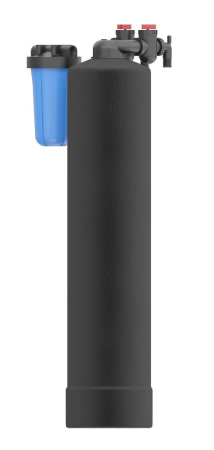
August 2025
By: Josh Walejewski
Read Time: 2-3 Minutes
August is National Water Quality Month, so it’s the perfect time to talk about hard water and water softeners. Shout-out to our reader Debra S. for suggesting this topic! Debra asked us: What are the differences between traditional water softeners and salt-free versions? Do they do the same thing, and is one better than the other?
Thank you, Debra, for the great question. In this article, we’ll clear up the confusion and set the record straight on salt-based vs. salt-free systems.
Hard Water 101: Why Soften Your Water?
Water containing high levels of dissolved minerals (mainly calcium and magnesium) is defined as being “hard”. Hard water isn’t dangerous to health, but it can be a nuisance in your home. Those minerals cause scale buildup inside plumbing and water-using appliances (like your water heater or coffee maker), leaving crusty mineral deposits on faucets and showerheads.
Hard water also causes spotty, cloudy residue on glassware and dishes, and it makes soap less effective. Over time, scale from hard water can shorten the life of appliances and clog up your pipes. These are the main reasons many homeowners choose to remove hardness from water.
Traditional Salt-Based Water Softeners (Ion Exchange)
 Traditional salt-based water softeners are the most common solution for hard water. They use a technology called ion exchange to physically remove calcium and magnesium ions from your water.
Traditional salt-based water softeners are the most common solution for hard water. They use a technology called ion exchange to physically remove calcium and magnesium ions from your water.
Here’s how it works in simple terms:
Inside the water softener’s resin tank are millions of tiny beads coated with a negatively charged resin. The beads act like a magnet for positively charged minerals like calcium, magnesium, and iron that plague our water. As hard water flows through the resin tank, the unwanted minerals cling to the resin beads, leaving the water flowing throughout your home soft and clean.
After so much hard water has passed over the resin beads, the regeneration cycle must begin. When the resin beads become covered with minerals, it’s time for a thorough rinse and recharge. During regeneration, a carefully orchestrated sequence of backwashing, brine rinsing, and rinsing ensues, flushing out accumulated minerals and recharging the resin beads to their pristine state. This process ensures that your water softener remains at peak performance, ready to tackle the next wave of hard water.
Benefits of Salt-Based Softeners
Salt-based softeners completely eliminate hard water minerals, which provides a host of benefits for your home. For example, water softeners:
Prevent scale buildup in pipes, water heaters, and appliances (no more crusty calcium deposits). This protects your plumbing and helps appliances like your dishwasher and water heater last longer.
Give cleaner, spot-free dishes and glassware. Soft water doesn’t leave the white film or water spots that hard water often does.
Improve soap performance and lather. With the hardness minerals gone, soaps and shampoos can foam up and rinse off better. You’ll notice more suds and less soap scum.
Leave skin and hair feeling softer. Many people find that bathing in soft water leaves their skin moisturized and their hair smoother.
Keep laundry bright and soft. Soft water prevents the mineral dullness on clothes, helping colors stay vibrant and fabrics feel softer.
In short, traditional softeners solve nearly all the common hard water problems. It’s no surprise that water professionals often consider ion-exchange softeners the gold standard for dealing with hard water.
Drawbacks of Salt-Based Softeners
No solution is perfect. Salt-based softeners do have a few considerations to keep in mind:
Environmental Impact: A study cited on wisaltwise.com covering the Waterloo Region and City of Guelph, estimates that traditional saltwater systems waste 1.9 billion litres of water each year for routine upkeep and release about 25,000 metric tons of salt into the local ecosystem and watersheds.
Maintenance: You’ll need to refill the salt periodically and perform occasional upkeep.
Salt and Sodium: treated water will have a small amount of sodium in it. The sodium level is usually quite low and undetectable but it’s something those on very strict low-sodium diets or with salt-sensitive houseplants might note.
Ongoing costs: The addition of salt means ongoing costs for salt bags. The unit also uses water and requires electricity to clean itself during regeneration, which means a bit of extra water and energy usage.
Space and Installation: A traditional softener typically has two tanks (resin and brine), so you need space for the equipment and access to a drain and electrical outlet.
Next, let’s look at the newer kid on the block – sometimes mistakenly referred to as “salt-free” softeners – and see how they compare.
Salt-Free Water Softeners aka Water Conditioners
 You may have seen devices advertised as salt-free water softeners. However, salt-free water softeners do not exist. The correct name for them is salt-free water conditioners, because technically they do not “soften” water by removing hardness minerals.
You may have seen devices advertised as salt-free water softeners. However, salt-free water softeners do not exist. The correct name for them is salt-free water conditioners, because technically they do not “soften” water by removing hardness minerals.
In fact, researchers agree that the “salt-free softener” label is incorrect and misleading. Only a process that removes calcium and magnesium can truly soften water. Salt-free systems condition the water to reduce scaling effects, but they do not remove the hard minerals. So what do these systems actually do?
Most salt-free conditioners use a template-assisted crystallization (TAC) process to combat hard water. Instead of extracting calcium and magnesium, a TAC system crystallizes them into microscopic particles that are suspended in the water.
The unit contains a special media (often a polymer resin bead with tiny nucleation sites) that acts as a catalyst. As hard water passes through, the hardness ions are induced to form micro-crystals on the media surface. When the crystals grow to a certain size, they detach and flow out with the water.
The key idea is that once the minerals have crystallized, they tend not to stick as scale on pipes and surfaces. The hard minerals are still in the water, but they are in a form that is less prone to clinging to your plumbing. This results in reduced scale buildup inside water heaters, pipes, fixtures, and appliances.
Pros of Salt-Free Conditioners
Salt-free systems have gained popularity largely because of their low-maintenance and eco-friendly appeal. Here are some advantages of salt-free water conditioners:
Scale Prevention: A good salt-free conditioner can significantly reduce new scale formation inside pipes and appliances by preventing mineral buildup
No Salt or Chemicals: As the name suggests, you don’t need to buy or add salt (or any chemicals) at all. This makes upkeep very simple – no heavy salt bags to lug around, and no added sodium in your water.
Environmental Friendliness: A Salt free conditioner greatly reduces the environmental impact of salt entering our eco-systems. Chloride/salt from traditional water softeners pass through wastewater treatment plants and enter rivers and streams, impacting aquatic life and water quality.
Minimal Maintenance: There are no regular refills or electrical components in many salt-free units. Once installed, a salt-free conditioner can run for years with little intervention (the conditioning media might need replacement after a number of years, but not frequently).
No Wastewater or Electricity: Salt-free conditioners operate in-line with your plumbing and typically don’t require a regeneration cycle or a drain line. This means they don’t waste water or add to energy costs.
Compact Size: Most salt-free conditioners are a single tank or cartridge, smaller than the two-tank salt softener setup. This can be a plus if space is tight.
These features make salt-free conditioners an attractive alternative, especially for homeowners who want to avoid salt due to environmental reasons or personal preference.
Salt-Free Conditioners Considerations and Limitations
It’s crucial to understand that a salt-free conditioner does not deliver the same results as a traditional softener. Both types of systems address hard water, but in different ways – and with different outcomes. Here are some key limitations of salt-free systems:
No Actual Softening: As mentioned, salt-free conditioners leave minerals like calcium and magnesium in your water.
Limited Effect on Soap and Cleaning: Salt-free units do not improve soap lather, keep laundry bright and soft, or prevent water marks like a traditional softener does.
Water Feel: Many people can feel the difference between truly soft water and conditioned water. Softened water tends to have a silky, “slippery” feel on skin which leaves hair and skin soft. If you’re used to soft water, conditioned water might not give you that luxurious lathering feeling you’re accustomed to.
Unproven Claims and Variability: The effectiveness of salt-free conditioners can vary with water conditions. Very high hardness water, or water with significant iron or sediment, may reduce a conditioner’s performance (pre-filtering or pretreatment might be needed in such cases). Consumers should be wary of any exaggerated claims and look for independent test data when considering a salt-free system.
To sum up, a salt-free conditioner’s primary job is preventing scale buildup. If your main goal is protecting your plumbing and appliances from hard water scale without the maintenance of a salt-based system, a salt-free conditioner can be a useful tool. Just go in with realistic expectations: you’ll still have “hard water”.
Conclusion
In summary, traditional salt-based water softeners and salt-free water conditioners are not the same and the terminology can be misleading. A “salt-free softener” does not actually soften the water or remove hardness; it conditions the water to help prevent scale buildup.
Traditional softeners remain the go-to if you want to completely solve hard water issues throughout your home, while salt-free conditioners can be an eco-friendly, no-fuss way to reduce scaling in your pipes. Each has its place, but it’s important to understand their differences so you won’t be fooled by marketing claims or have the wrong expectations.
Remember, during National Water Quality Month (and year-round), it’s worth thinking about your home’s water quality and how it affects life around us. In case you missed it, click here to learn the importance of protecting one of Wisconsin’s most vital resources.
Read more blog posts from Kettle Moraine Heating & AC.
About the Author
Josh Walejewski
Josh is a business professional who has worked in the HVAC industry since 2017. With a Bachelor of Applied Arts and Sciences Degree (B.A.A.S) in marketing and sustainable business management from the University of Wisconsin, he has a passion for all aspects of HVAC, business, marketing, and environmental stewardship.




